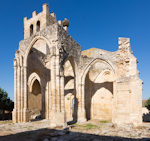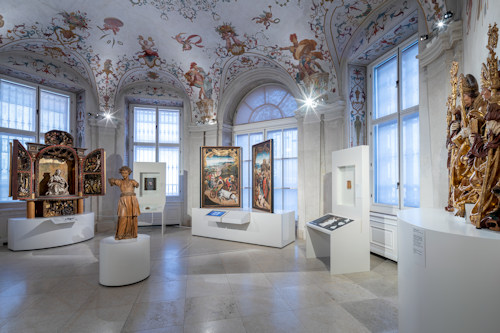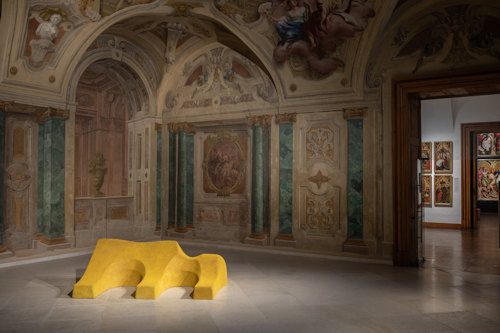
Belvedere is most famous for its more recent art: Klimt, Schiele and the like. But the Upper Palace also houses a collection from a time when a Klimt painting might have started a religious war.
- Small exhibition of masterpieces by medieval & early Renaissance artists
- The Belvedere is a dynamic museum, so the actual works on display may vary
- All information also presented in English
- Book Upper Belvedere tickets* online
- See also:
Contemporary & medieval?

(Exhibition view Picture this! The Belvedere Collection from Cranach to EXPORT; photo: Johannes Stoll / Belvedere, Vienna)
Several rooms on Upper Belvedere’s ground floor begin your chronological journey through the prestigious art collection.
In this Middle Ages to Renaissance part, we start with fine examples of Gothic and Romanesque religious works, then end with art broadening its wings to serve other functions in the early Renaissance.
The first room, though, offers something entirely different.
This is the palace’s former large summer drawing room, with wall and ceiling paintings that give the illusion you’re looking at three-dimensional architecture, rather than a flat painting.
These illusionist paintings mix in nicely with actual arches, making it hard to distinguish between what’s real and what’s fake (plus ça change). The central ceiling also features a celestial theme around the figures of Aurora and Apollo.
This Carlone Hall is quite beautiful and also home to a series of contemporary exhibitions; every six months or so, an invited artist presents a modern work that fits within this particular architectural context and imagery.

(View of a Carlone Contemporary exhibition installation: Aldo Rossi’s Sleeping Elephant by Lena Henke © Johannes Stoll / Belvedere, Wien)
The historical art
The bulk of Belvedere’s medieval collection actually appears in the former stables, but the masterpieces are in Upper Belvedere. They begin with a wooden crucifix depiction from over 800 years ago and end in the early 1500s with the likes of Lucas Cranach the Elder.
So what are perhaps the highlights?
The Znaim altarpiece
One room focuses on 15th-century altar panels, including the 1440s altarpiece from Znaim (in today’s Czechia) along one wall.
The realistic reliefs carved from lime and spruce detail chaotic Crucifixion scenes: the original colours remain clear around 700 years later. (700 years!)

(Znaimer Altar. Photo courtesy of and © Belvedere, Wien; reproduced with permission under the terms of Creative Commons License CC BY-SA 4.0.)
Masters at work
A collection of late-Gothic panel paintings opposite the Znaim altarpiece includes two panels by the Master of the Schottenaltar from around 1470.
The other altar panels from the set appear in the Schottenstift Museum and are notable for often portraying biblical scenes with contemporary clothing and backgrounds (including 15th century Vienna). So their value to historians is enormous.
The same room also features panels by Michael Pacher (around 1435-1498) and Marx Reichlich (around 1460-1520) from the late 1400s and early 1500s. Their works leap out at you because of the sudden jump in quality.
Even the untrained eye sees how both use depth and perspective to stand out from their peers.
Change ahead

(Master of the Krainburg Altarpiece, The Martyrdom of the Sts. Cantius, Cantianus, and Cantianilla (Detail), c. 1510; photo: Johannes Stoll / Belvedere, Vienna)
The final room in this section still features its original grotesque frescoes (Roman-style decorative scrollwork), dedicated to the deeds of Aeneas.
These frescoes provide another classical reference of the kind much loved by Prince Eugene (Belvedere’s original owner and a man quite happy to draw parallels between his many exploits and the heroes of Greek and Roman mythology).
The room illustrates the transition of art away from Gothic styles, religious motifs and ecclesiastical purposes: a change that includes growing self-awareness among artists of their role as skilled individuals.
So we have, for example, altar panels where the artists insert themselves into the picture, as nicely explained for the Krainburg altarpiece and an anonymous master.
A highlight here is undoubtedly the 1530/1540 The Odd Couple painting by Lucas Cranach the Elder (subject of a 2022 solo exhibition elsewhere).
Incidentally, if you enjoy medieval art, can I recommend the Kunstkammer at the Kunsthistorisches Museum? Many of the works within date back to a similar time period. Plus you get to see the glory that is the Saliera.
Next on your trip around Upper Belvedere: the Baroque, Neoclassicism & Biedermeier section.